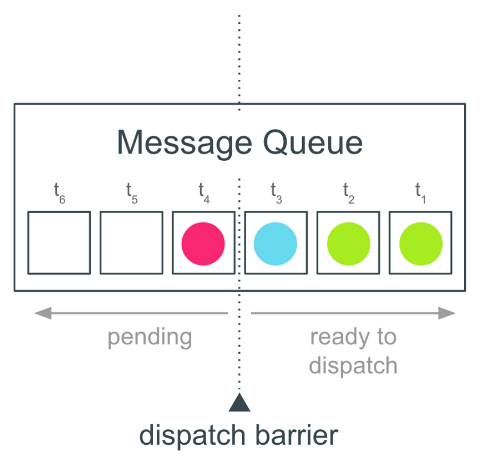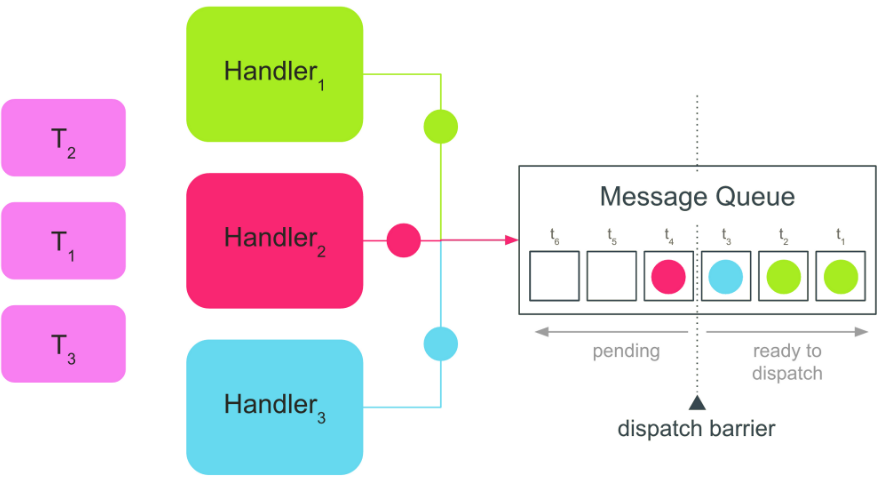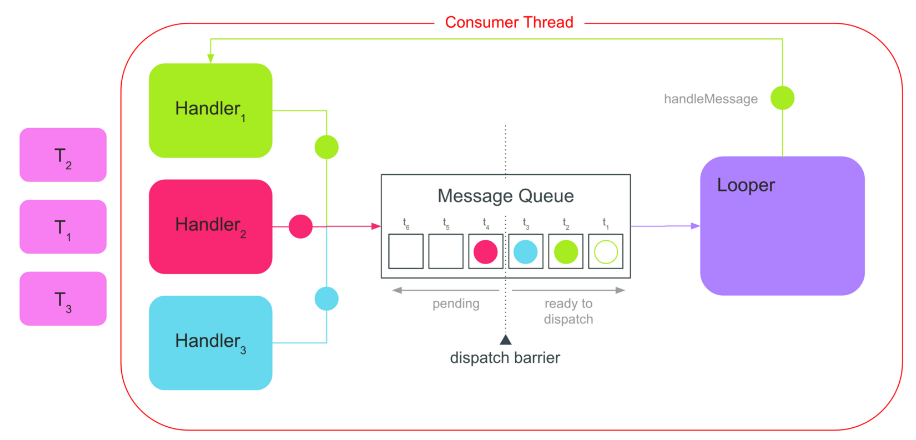当Activity创建好之后,UI线程便处于等待消息阶段,当用户做完了某件事情之后可以向UI线程发送消息,如更新控件,刷新界面。最常见的就是从网络加载完图片后将其显示出来,显示操作必须在UI线程执行。
那么,由谁在工作线程中发送这个消息,又是谁在UI线程中执行消息呢?
当然是Handler了
Handler由以下部分组成:
- Handler
- Looper
- MessageQueue
- Message
我们需要弄清楚的问题
- 消息从哪里产生?
- 谁来发送消息?
- 消息发送到哪里去?
- 谁来处理消息?
把上面的问题全部明白了,那么Handler机制也就完全理解了。
消息一般是由工作线程产生的,因为一旦工作线程完成了某件事情,它会通知主线程,所以工作线程产生消息。
产生消息的方式:
Message msg=Message.ontain();
msg.what=IMAGE_LOAD_SUCCESS;
//这条消息用来说明,图片已经加载成功
发送消息:
hanlder.sendEmptyMessage(msg);
下面,问题来了,消息要发送到哪去呢?
实际情况是,当Handler创建的时候,他会与Looper进行绑定,每一个Looper创建的时候都对应了一个MessageQueue,那么handler也就绑定了相应的MessageQueue,handler会把消息发送到该MessageQueue中。
且看Handler的构造函数:
<code>
public Handler(Callback callback,boolean async){
//code removed for simplity
mLooper=Looper.myLooper();
if(mLooper==null){
throw new RuntimeException("can not create handler inside thread that has not call Looper.prepare()");
}
mQueue=mLooper.mQueue;
mCallback=callback;
}
</code>
Attention:同一线程中的多个Handler分享同一个消息队列,因为他们共享的是同一个Looper对象
那么,消息最后是由谁来执行的呢?
MessageQueue中的message最后会被Looper取到,Looper会查看Message对象中的target变量,他就是处理该Message的对象,也就是我们发送消息的那个handler对象,Looper会调用handler的handleMessage()方法。
MessageQueue

![[Handler内部逻辑]](/images/Handler-internal/handler_internal_01.png)
在发送消息的时候,我们可以发送延迟消息
handler.sendMessageDelayed(Message msg,long delayMillis);
每一个Message对象都带有when参数,如果这个参数小于消息队列中的dispatch barrier,那么Looper就可以取到这条消息,否则是取不到的
Handler、MessageQueue、线程(生产线程、消费线程)之间的交互如下:

Looper
Looper从消息队列中读取消息,然后分发给对应的Handler处理,一旦超过了阈值,那么Looper就会在下一轮读取过程中读到该Message。Looper在没有消息分发的时候会变成阻塞状态(执行线程被阻塞),当有消息时继续轮询(执行线程被唤醒)。
每个线程只能关联一个Looper,问题来了,这是怎么实现的?这就要从Looper的构造方法出来,看看他的实例是怎么被创建出来的就明白了。

我们通过Looper.myLooper()方法拿到一个Looper实例对象,且看该方法的说明
/**
* Return the Looper object associated with the current thread. Returns
* null if the calling thread is not associated with a Looper.
* 返回与当前线程相关联的Looper对象,如果该线程还没有关联Looper对象,那么返回null
*/
public static @Nullable Looper myLooper() {
return sThreadLocal.get();
}
那么,Looper对象到底在哪里被关联的呢?
private static void prepare(boolean quitAllowed) {
if (sThreadLocal.get() != null) {
throw new RuntimeException("Only one Looper may be created per thread");
}
sThreadLocal.set(new Looper(quitAllowed));
}
我们且不管ThreadLocal的内部实现原理如何,他的作用就是将对象与线程关联,一个线程一定与一个Looper实例对象关联。
更深层次的思考
一般情况下(99.99%),我们只会向UI线程的消息队列中发送消息,但要是你哪天兴致来了,自己new了一个Thread,而且你打算给这个线程发送消息,那么你需要做哪些工作呢?
当你new Thread 得到一个线程对象时,它此时并没有和Looper关联,难道我还要自己去创建Looper?
放心,这么艰巨的任务还轮不到你来做,Android提供了一个简单的类来一步搞定—HandlerThread,他是Thread的子类,并提供对Looper创建的管理。
且看示例代码:
private HandlerThread handlerThread;
@Override
protected void onCreate(@Nullable Bundle savedInstanceState) {
super.onCreate();
handlerThread = new HandlerThread("HandlerDemo");
handlerThread.start();
handler = new CustomHandler(handlerThread.getLooper()); //绑定handlerThread对应的Looper
}
@Override
protected void onDestroy() {
super.onDestroy();
handlerThread.quit(); //在Activity被销毁的时候,终止这个线程,相应的Looper也会被终止
}

